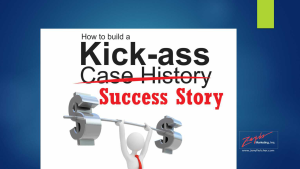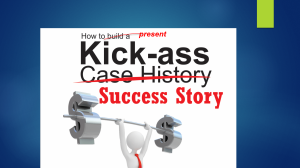“For starters,” I said to Nina, “don’t call it that.”
Gail, the wordsmith in our midst agreed. She said, “I like your term Success Story a lot better.” (Video: How to get the data you need for a Kick-ass Case History https://youtu.be/UcvpMkBynYk)
“But, sometimes things aren’t successful,” said Chris. “In my digital retail marketing operation we often try things that just don’t work at all.”
“But that, young pup, is just findin’ out that you’re barkin’ up the wrong tree,” said Rob our southern fried Brand Guru. “Indeed,” he went on, “in my book that is a success.”(Get the PDF of the Kick-ass Case History form)
Rick raised his voice to be heard over a crash of dishes from the kitchen and said, “Most people think that a case history has to be only about what works but I’ve always found the most valuable experiences are the ones that teach you what doesn’t. Selling direct, like I do, has always been a laboratory. That’s why we test before putting up big bucks. What I’m trying to say is that keeping good solid info every time out of the chute is the only way to really know.”
“If you’re selling, like I do every day, the marketing and sales train wrecks are sometimes the best to convince a buyer,” said Kate. “Being able to give somebody hard data on an approach that didn’t work makes it a lot easier to get them to sign off on one that does. The other thing it does is it gives you a reason to walk away from a prospect if you know they are going to fail or to suggest a test that could make both you and them look good.”
Nina, our luncheon guest, looked around the table wide-eyed and said, “All I really wanted was to put some information on my website that tells people what I’ve been able to accomplish with my clients. It seems like there is a whole lot more to this than I thought. “
“You betcha, sweet pea,” drawled Rob. Most of us have been advising professionals and particularly consultants long enough to know that you need to look at keepin’ track of every engagement and assignment in a way that allows you to use all the information later.” (Video: How to present a Kick-ass Success Story in print) https://youtu.be/KM_lH2Eqrqo )
“All assignments and engagements,” I emphasized. Here’s a rough list of the ones I think you should keep track of:
- Client Prospecting
- Referral Approaches
- Proposal based engagements
- Assignments based on a retainer agreement
- Projects awarded for previous experience
- Engagements that require training or retraining of client staff
- Situations that require you, the client or both to stretch
“So you’re saying to keep track of it whether it is business development, business as usual or business with a twist,” said Kate.
“Well put,” I responded. “Early on having a simple form that you fill out helps get you organized to do it. Later, you may pick and choose which of the jobs you take on to do a full write up on but it never hurts to have the information.” Kick Ass Case History Capture Form
Nina asked, “So what is on the form?” (PDF of form)
“All the usual client ID stuff, the kind of project, start and end date, situation, objective, starting data, ending data,” I said.
Rob said, “I like to keep a file with the form. You don’t want to forget any branding data that you might want when you report on it. That could be things like a logo or photos of the client and the client’s business or products. And if graphics are important it is a good idea to have before and after stuff.”
“Words, too,” added Gail. “When you change Mission or Position or Value Proposition it is a good idea to have both the before and after. Other word oriented items I like to include are testimonials. If I’m working with multiple levels than I try to get them from each. And I always like to get them to include the numeric changes in their statements.”
“Don’t overlook video,” said Chris. “If you can get a video that demonstrates what you do or just the client talking about what you’ve done for them you have a winner. What our studies show is that video seems to be the most convincing way to get a point across these days. “Video: One way to do a Kick-ass Video Success Story https://youtu.be/KPCU79FgXvE) 
Kate looked over her glasses at Nina and said, “All that hard data is good. But remember we’re dealing with human beings here. There is a great deal of emotion wrapped up in what we do. Change isn’t easy. Transformation is what we are really doing. People are scared of it. They shy away from it. And then when the work we do kicks in they become proud of it. Don’t forget to capture that emotional content and the newfound strength you help provide. “
“You keep a file like that and you’ll be able to build a powerful Success Story to publish on the ones that work. You keep the data on the ones that don’t and make that into a Case History by adding one thing: your investigations in to why the anticipated results didn’t happen.”
The Takeaway
To build a Kick-ass Success Story you need to capture the information on every major project or engagement or assignment. Keep a file that doesn’t rely on memory to help you gather the data and materials you need. Then express it in a way that lets people “get it” in whatever medium you are using to present it .
Jerry Fletcher’s blog recaps conversations with clients, prospects and the unruly mob of business development professionals he consorts with. They discuss marketing that works from solopreneur to enterprise level. Jerry Fletcher is the ringleader and “Watson” of the dialogue. Sign up for the blog and other publications at: www.JerryFletcher.com/Profit.html
Jerry has been researching and implementing small business marketing that builds businesses, careers and lives of joy for 25 years as President of Z-axis Marketing, Inc. Learn more at www.JerryFletcher.com
Schedule a personal appearance. Jerry speaks internationally on Networking, Marketing and Contact Relationship Magic. www.NetworkingNinja.com


